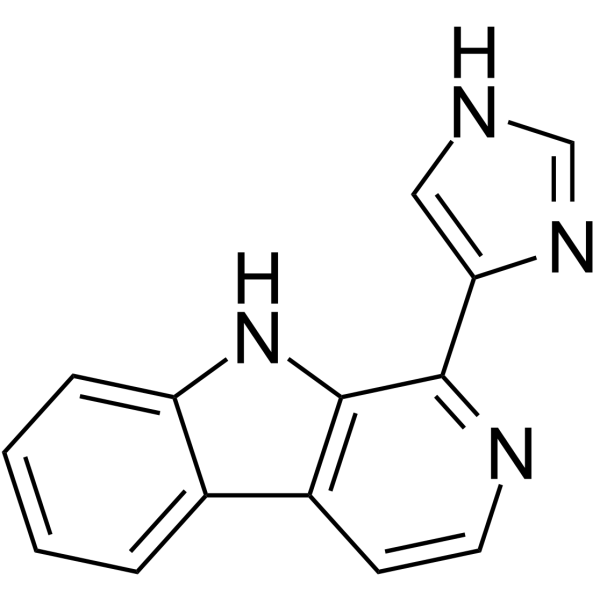| Description |
IDO1/TDO-IN-4 is a potent IDO1/TDO dual inhibitor, with IC50 values of 3.53 μM (IDO1) and 1.15 μM (TDO). IDO1/TDO-IN-4 forms hydrogen bond with IDO1, and π−π stacking interaction with TDO. IDO1/TDO-IN-4 can be used in the research of depression, and depression-induced infectious, metabolic, and autoimmune disorders[1].
|
| Related Catalog |
|
| Target |
IDO1:3.53 μM (IC50)
|
| In Vitro |
IDO1/TDO-IN-4 (compound 28, 0-2 μM, 1 h) inhibits the LPS-induced activation of BV2 microglial cells (determined by morphological changes)[1]. IDO1/TDO-IN-4 (0-2 μM, 1 h) inhibits the generation of pro-inflammatory factors and promotes the expression of IL-10[1]. IDO1/TDO-IN-4 (0-2 μM, 1 h) decreases the expression of IDO1 and prevents the excessive degradation of tryptophan via the kynurenine pathway[1]. RT-PCR[1] Cell Line: 100 ng/mL LPS-induced BV2 microglial cells Concentration: 0, 0.25, 0.5, 1, 2 μM Incubation Time: 1 h Result: Inhibited the generation of COX2, iNOS, TNF-α, and IL-1β. Increased the level of IL-10.
|
| In Vivo |
IDO1/TDO-IN-4 (compound 28, i.p., 20 mg/kg, at day 1, 2, 3) rescues LPS-induced neuroinflammation and depressive-like behavior in mice[1]. IDO1/TDO-IN-4 (I.p. or i.v., 20 mg/kg) displays high exposure and a high volume of distribution at the steady state in normal mice[1]. Animal Model: 2 mg/kg LPS-induced depressive mice[1] Dosage: 20 mg/kg Administration: Intraperitoneal injection (i.p.), at day 1, 2, 3. Result: Attenuated microglial activation significantly. Decreased inflammatory factors in the hippocampus, such as TNF-α, IL-1β, and iNOS. Downregulated LPS-induced overexpression of IDO1. Animal Model: Male C57BL/6J mice (pharmacokinetic assay)[1] Dosage: 20 mg/kg Administration: Intraperitoneal injection and intravenous injection Result: Pharmacokinetic profile of IDO1/TDO-IN-4 (compound 28) pharmacokinetic property T1/2 (h) Tmax (h) Cmax (ng/mL) bioavailability F (%) i.v./i.p. 2.31/0.77 0.25 5543.99/3878 52.55
|
| References |
[1]. Yu Zhang, et al. B Discovery of 1-(Hetero)aryl-β-carboline Derivatives as IDO1/TDO Dual Inhibitors with Antidepressant Activity. J Med Chem. 2022 Aug 7.
|
